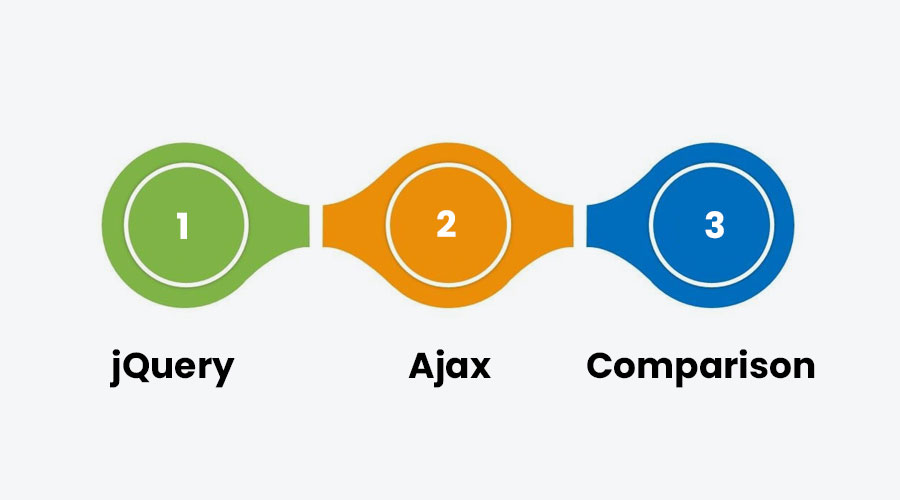Table of Contents
Introduction to jQuery and Ajax
In the ever-evolving landscape of web development, mastering the fundamentals of JavaScript libraries like jQuery and techniques such as Ajax can significantly enhance your capabilities. Whether you’re a seasoned developer or just dipping your toes into the realm of web development, understanding these tools is crucial for building dynamic and interactive web applications. In this article, we’ll delve into the basics of jQuery and Ajax, exploring their functionalities, benefits, and how they work together to create seamless user experiences.
Understanding jQuery: jQuery, often hailed as a fast, small, and feature-rich JavaScript library, simplifies the process of traversing HTML documents, handling events, animating elements, and Ajax interactions. Its concise syntax and broad compatibility across various browsers make it a go-to choice for developers aiming to streamline their coding process.
One of the key features of jQuery is its ability to select elements in the Document Object Model (DOM) using CSS-style selectors, allowing developers to manipulate them effortlessly. Whether it’s updating the content of a webpage dynamically or animating elements to enhance user engagement, jQuery provides a plethora of methods and functions to accomplish these tasks with minimal code.
The Power of Ajax: Ajax, short for Asynchronous JavaScript and XML, revolutionized web development by enabling asynchronous data retrieval from a server without needing to refresh the entire page. This approach enhances user experience by delivering seamless interactions, such as dynamically loading content, submitting form data without page reloads, and updating parts of a webpage in real-time.
At the heart of Ajax lies the XMLHttpRequest object, which facilitates communication between the client and server asynchronously. By sending requests to the server in the background and processing responses without disrupting the user’s browsing experience, Ajax empowers developers to create dynamic and responsive web applications.
Integrating jQuery with Ajax: Combining jQuery with Ajax unleashes a powerful synergy, amplifying the capabilities of both technologies. jQuery simplifies the process of making Ajax requests by providing a suite of methods, such as $.ajax(), $.get(), and $.post(), which abstract away the complexities of working with the XMLHttpRequest object.
With jQuery’s intuitive syntax and Ajax’s asynchronous nature, developers can effortlessly fetch data from a server, update the DOM dynamically, and handle server responses seamlessly. Whether it’s fetching data from an API, implementing infinite scrolling, or building interactive forms, the jQuery-Ajax duo empowers developers to create robust and engaging web applications with ease.
Core Functionality: Understanding jQuery
In the realm of web development, jQuery stands tall as one of the most powerful and widely used libraries. Its versatility and ease of use have made it an indispensable tool for developers across the globe. But what exactly is jQuery, and what are its core functionalities? Let’s delve deeper into this dynamic library to understand its essence.
What is jQuery?
jQuery is a fast, small, and feature-rich JavaScript library. It simplifies HTML document traversing, event handling, animating, and Ajax interactions for rapid web development. Essentially, it allows developers to write less code while accomplishing more.
Core Functionalities of jQuery:
- DOM Manipulation: jQuery excels in manipulating the Document Object Model (DOM), which represents the structure of an HTML document. With jQuery, developers can easily select elements from the DOM and perform actions such as adding, removing, or modifying them. This simplifies tasks like updating content dynamically or handling user interactions effectively.
- Event Handling: Events play a crucial role in web development, facilitating user interactions such as clicks, mouse movements, or keyboard inputs. jQuery offers a streamlined approach to handling events, allowing developers to attach event listeners to elements and execute specific actions in response to those events. This makes web applications more interactive and responsive.
- Animation Effects: jQuery provides a suite of animation methods that enable developers to create captivating visual effects effortlessly. Whether it’s fading elements in and out, sliding them across the screen, or animating their properties, jQuery offers a rich set of animations to enhance the user experience.
- Ajax Interactions: Asynchronous JavaScript and XML (Ajax) enables web pages to dynamically fetch and display data without reloading the entire page. jQuery simplifies Ajax interactions by providing methods to make asynchronous requests to the server, handle responses, and update the page content accordingly. This results in smoother, more dynamic web applications.
- Utilities: In addition to its core functionalities, jQuery offers a range of utility methods that facilitate common tasks such as manipulating arrays, working with strings, and performing miscellaneous operations. These utilities enhance productivity and enable developers to accomplish tasks efficiently.
Why Understanding jQuery Matters:
Understanding jQuery is essential for any web developer due to several reasons:
- Efficiency: jQuery streamlines common tasks and simplifies complex operations, allowing developers to write cleaner and more concise code.
- Compatibility: jQuery abstracts away browser inconsistencies, ensuring consistent behavior across different platforms and browsers.
- Productivity: By providing a wealth of built-in functionalities and plugins, jQuery accelerates the development process, enabling developers to build feature-rich web applications in less time.
- Community Support: jQuery boasts a vast community of developers who actively contribute plugins, tutorials, and resources, making it easier for newcomers to learn and seasoned developers to stay updated.
Syntax and Usage: jQuery
In the realm of web development, jQuery stands tall as a powerful and versatile JavaScript library. Whether you’re a seasoned developer or just dipping your toes into the world of coding, understanding its syntax and usage can significantly enhance your ability to create dynamic and interactive web experiences. Let’s delve into the intricacies of jQuery, unraveling its syntax and exploring its myriad applications.
Understanding the Syntax:
jQuery’s syntax is designed to be intuitive and concise, making it accessible to developers of all levels. At its core, jQuery revolves around the principle of selecting HTML elements and performing actions on them. Here’s a breakdown of its fundamental syntax:
- Selecting Elements: jQuery employs CSS-style selectors to target HTML elements. For instance, to select all paragraphs on a webpage, you would use
$('p'). Similarly,$('.classname')selects elements with a specific class, while$('#id')targets elements by their unique ID. - Performing Actions: Once elements are selected, jQuery enables you to manipulate them with ease. Common actions include modifying content (
text(),html()), altering CSS properties (css()), handling events (click(),hover()), and traversing the DOM (find(),parent(),siblings()). - Chaining Methods: jQuery allows method chaining, enabling you to perform multiple actions in a single line of code. This not only enhances readability but also improves performance by minimizing DOM traversal.
Exploring Usage Scenarios:
jQuery’s versatility extends across a wide array of applications, making it indispensable in modern web development. Here are some common scenarios where jQuery shines:
- DOM Manipulation: jQuery simplifies DOM manipulation tasks, such as adding or removing elements, altering content dynamically, and updating styles based on user interactions. Its concise syntax streamlines these operations, resulting in cleaner and more maintainable code.
- Event Handling: With jQuery, event handling becomes a breeze. You can attach event listeners to elements and define corresponding actions, facilitating seamless user interactions. Whether it’s handling clicks, key presses, or mouse movements, jQuery empowers you to create responsive and interactive web interfaces effortlessly.
- AJAX Requests: jQuery streamlines AJAX (Asynchronous JavaScript and XML) requests, enabling you to fetch data from servers without page reloads. Its
$.ajax()function provides a simplified interface for making HTTP requests, handling responses, and updating the DOM dynamically. This is particularly useful for building dynamic web applications that fetch data asynchronously. - Animation Effects: jQuery simplifies the creation of animation effects, allowing you to animate CSS properties, create custom animations, and add visual flair to your web pages. Whether it’s fading elements in and out, sliding them across the screen, or implementing complex animations, jQuery offers a rich set of features for bringing your designs to life.
Syntax and Usage: Ajax
In the ever-evolving landscape of web development, Ajax stands as a pivotal technology, facilitating seamless communication between web servers and browsers without the need for page refreshes. Its significance in enhancing user experience cannot be overstated. However, for developers, mastering the syntax and understanding its usage is crucial to leveraging its full potential effectively.
Understanding Ajax:
Ajax, which stands for Asynchronous JavaScript and XML, is not a single technology but rather a combination of several existing ones. At its core, Ajax utilizes JavaScript for sending and receiving data asynchronously between a client and a server. XML was initially used for data exchange, but nowadays, JSON (JavaScript Object Notation) has become more prevalent due to its lightweight and human-readable format.
The Syntax:
At the heart of Ajax lies a few key methods and objects within JavaScript:
- XMLHttpRequest Object: This object is the cornerstone of Ajax. It provides the ability to communicate with the server asynchronously and update the content of a web page without reloading it.
- open() Method: This method initializes a request, specifying the HTTP method (GET or POST) and the URL of the server-side script to which the request is sent.
- send() Method: Once the request is initialized, the send() method sends the request to the server. For POST requests, data can be included in the send() method.
- onreadystatechange Event Handler: This event handler is triggered whenever the readyState property of the XMLHttpRequest object changes, indicating that the state of the request has been altered.
- readyState Property: This property holds the status of the XMLHttpRequest object. It ranges from 0 to 4, with each number representing a different stage of the request.
- responseText and responseXML Properties: These properties hold the response data returned by the server. The responseText property contains the response as a string, while the responseXML property contains the response as an XML document.
Usage:
Ajax finds applications in various scenarios, such as:
- Dynamic Content Loading: Ajax enables loading content dynamically without reloading the entire web page. This is commonly seen in social media feeds, where new posts are fetched and displayed as the user scrolls.
- Form Submission: Instead of reloading the entire page upon form submission, Ajax can be used to send form data to the server in the background and update only specific parts of the page based on the server’s response.
- Real-Time Data Updates: Websites that require real-time updates, such as chat applications or stock market trackers, utilize Ajax to fetch and display new data without user intervention.
- Autosave Functionality: Ajax can be employed to automatically save user input in web forms without requiring manual submission, providing a seamless user experience.
SEO Optimization:
When implementing Ajax on a website, it’s crucial to consider SEO implications. Since search engine crawlers may have difficulty parsing dynamically loaded content, it’s essential to ensure that critical content is still accessible in the HTML source code or provide alternative means for search engines to index the content.
DOM Manipulation: jQuery vs. Ajax
In the realm of web development, DOM manipulation is a crucial aspect that enables developers to dynamically interact with web pages. jQuery and Ajax are two popular tools used for this purpose, each offering its own set of advantages and use cases. In this article, we will delve into the differences between jQuery and Ajax for DOM manipulation, helping you decide which one best suits your needs.
jQuery: The Swiss Army Knife of DOM Manipulation: jQuery has been a staple in web development for years, renowned for its simplicity and ease of use. It provides a concise syntax for traversing and manipulating the DOM, allowing developers to perform tasks such as selecting elements, altering their attributes, and handling events with minimal code.
One of the key benefits of jQuery is its extensive library of plugins, which extend its functionality and provide solutions for various tasks, from creating interactive UI components to implementing complex animations. This vast ecosystem makes jQuery an attractive choice for projects that require rapid development and cross-browser compatibility.
Moreover, jQuery abstracts away many of the complexities of JavaScript, making it accessible to developers of all skill levels. Its intuitive syntax and comprehensive documentation ensure that even beginners can quickly grasp its concepts and start building interactive web applications.
Ajax: Asynchronous Power for Dynamic Content: Ajax (Asynchronous JavaScript and XML) is a technique that allows web pages to retrieve and display data from a server without requiring a full page reload. It enables seamless interaction with server-side resources, making it ideal for building dynamic web applications that deliver real-time updates to users.
Unlike jQuery, which primarily focuses on DOM manipulation, Ajax is specifically designed for handling asynchronous requests. It empowers developers to fetch data from a server in the background, update the DOM dynamically, and respond to user actions without interrupting the browsing experience.
Ajax is particularly well-suited for scenarios where responsiveness and performance are paramount, such as single-page applications (SPAs) and web applications with heavy client-server interaction. By leveraging Ajax, developers can create fluid and interactive interfaces that rival native desktop applications in terms of user experience.
Choosing the Right Tool for the Job: When it comes to DOM manipulation, the choice between jQuery and Ajax ultimately depends on the specific requirements of your project. If you’re building a simple website or need to perform basic DOM operations, jQuery provides a lightweight and intuitive solution that gets the job done efficiently.
On the other hand, if your application relies heavily on dynamic content and requires seamless communication with server-side resources, Ajax offers unparalleled flexibility and performance. By embracing the asynchronous nature of Ajax, you can create rich, interactive experiences that engage users and enhance the overall usability of your web application.
Event Handling: jQuery vs. Ajax
In the realm of web development, event handling plays a pivotal role in creating dynamic and interactive user experiences. Two commonly used tools for event handling are jQuery and Ajax. Both are powerful in their own right, but understanding their differences can help developers make informed decisions about which to use for their projects.
jQuery, a fast, small, and feature-rich JavaScript library, simplifies event handling by providing a unified interface for common tasks across different browsers. It abstracts away many of the complexities of JavaScript, making it easier to manipulate HTML documents, traverse the DOM, and handle events such as clicks, mouse movements, and keyboard inputs.
One of jQuery’s key strengths lies in its cross-browser compatibility. It handles the nuances of browser quirks, ensuring consistent behavior across various platforms. Additionally, jQuery’s extensive documentation and large community of users make it easy for developers to find solutions to their problems and learn new techniques.
On the other hand, Ajax (Asynchronous JavaScript and XML) is a technique used for creating asynchronous web applications. It allows data to be retrieved from a server without having to reload the entire page. Event handling in Ajax is typically used to manage interactions such as form submissions, fetching data from a server, and updating parts of a webpage dynamically.
Ajax provides developers with more flexibility and control over the communication between the client and server. By sending and receiving data asynchronously, Ajax can improve the responsiveness and performance of web applications. However, it requires a deeper understanding of JavaScript and server-side technologies to implement effectively.
When deciding between jQuery and Ajax for event handling, it’s essential to consider the specific requirements of your project. If you’re primarily dealing with DOM manipulation and simple interactions, jQuery may be the more straightforward option. Its intuitive syntax and extensive plugin ecosystem make it well-suited for rapid development and prototyping.
On the other hand, if you need to build complex, data-driven web applications with asynchronous interactions, Ajax may be the better choice. While it has a steeper learning curve, mastering Ajax opens up a world of possibilities for creating dynamic and responsive user interfaces.
In some cases, developers may choose to use both jQuery and Ajax together. jQuery can handle DOM manipulation and event binding, while Ajax can manage server-side interactions and data retrieval. By leveraging the strengths of both technologies, developers can create rich, interactive web applications that deliver an exceptional user experience.
Data Retrieval: jQuery vs. Ajax
In the realm of web development, efficient data retrieval plays a pivotal role in enhancing user experience and functionality. Among the array of tools available, jQuery and Ajax stand out as popular choices for handling asynchronous requests and fetching data from servers. But which one is better suited for your project? Let’s delve into the nuances of jQuery and Ajax to uncover their strengths and use cases.
jQuery: Simplifying DOM Manipulation: jQuery, a fast, small, and feature-rich JavaScript library, has long been favored for its simplicity in DOM manipulation and event handling. When it comes to data retrieval, jQuery.ajax() method provides a straightforward approach to make asynchronous HTTP requests.
One of the key advantages of using jQuery for data retrieval is its ease of implementation. With just a few lines of code, developers can initiate Ajax requests, handle responses, and update the DOM accordingly. Additionally, jQuery offers cross-browser compatibility, abstracting away the complexities of dealing with browser quirks and inconsistencies.
However, as web development has evolved, some argue that jQuery’s utility has diminished. With modern browsers offering native support for many features once provided by jQuery, some developers find it unnecessary to include the library in their projects, especially if data retrieval is the primary concern.
Ajax: Unleashing Asynchronous Power: Ajax, short for Asynchronous JavaScript and XML, is a foundational technique for building dynamic web applications. Unlike jQuery, which is a library, Ajax is a concept implemented using vanilla JavaScript or other frameworks/libraries like Angular or React.
The core strength of Ajax lies in its ability to perform asynchronous requests without requiring a page refresh. This makes it ideal for fetching data in the background, updating portions of a web page dynamically, and delivering a seamless user experience. Moreover, Ajax offers granular control over HTTP requests, allowing developers to customize headers, handle errors, and implement various authentication mechanisms.
While Ajax provides more flexibility and control compared to jQuery, it also requires a deeper understanding of JavaScript and the underlying HTTP protocol. Developers must handle tasks such as managing request states, implementing error handling, and dealing with cross-origin resource sharing (CORS) issues, which can be daunting for beginners.
Choosing the Right Tool for the Job: When deciding between jQuery and Ajax for data retrieval, it ultimately boils down to the specific requirements of your project and your familiarity with the technologies involved.
If you’re working on a small to medium-sized project and prefer a quick and easy solution with minimal boilerplate code, jQuery may be the way to go. Its intuitive syntax and broad browser support make it an attractive option for rapid prototyping and simple applications.
On the other hand, if you’re tackling a larger-scale project that demands fine-grained control over data retrieval and requires optimal performance, Ajax might be the better choice. While it involves a steeper learning curve, mastering Ajax empowers developers to harness the full potential of asynchronous communication and build robust, scalable web applications.
Asynchronous vs. Synchronous Requests
In the realm of web development and API integration, the choice between asynchronous and synchronous requests can significantly impact the performance and user experience of your application. Both approaches have their advantages and disadvantages, and understanding the differences between them is crucial for making informed decisions. In this article, we’ll delve into the intricacies of asynchronous and synchronous requests, exploring their characteristics, use cases, and considerations.
Synchronous Requests: Synchronous requests follow a traditional request-response model, where the client sends a request to the server and waits for a response before proceeding with the next action. This synchronous nature means that the client is blocked from performing any other tasks until it receives a response from the server. While synchronous requests are straightforward to implement and understand, they can lead to potential bottlenecks and performance issues, especially in scenarios where multiple requests need to be made sequentially.
One of the primary benefits of synchronous requests is their simplicity. Developers can easily reason about the flow of control in synchronous code, making it easier to debug and maintain. Additionally, synchronous requests are well-suited for applications where responses need to be processed in a specific order or where transactions must be atomic.
However, the synchronous nature of these requests can result in decreased responsiveness and scalability, particularly in high-traffic environments. If the server takes a long time to process a request or if network latency is high, the client may experience delays and unresponsiveness, leading to a subpar user experience.
Asynchronous Requests: In contrast to synchronous requests, asynchronous requests allow the client to send multiple requests to the server without waiting for each response individually. Instead, the client continues to execute other tasks while waiting for responses in the background. This non-blocking behavior enables better utilization of system resources and can significantly improve the responsiveness and scalability of an application.
Asynchronous requests are particularly beneficial in scenarios where the client needs to perform multiple independent tasks concurrently or when dealing with long-running operations such as file uploads, data processing, or network requests. By leveraging asynchronous programming techniques, developers can design applications that remain responsive even under heavy load, enhancing the overall user experience.
However, asynchronous programming introduces its own set of challenges, including increased complexity and potential issues with error handling and resource management. Asynchronous code can be harder to reason about, leading to potential bugs and maintenance challenges, especially for developers unfamiliar with asynchronous programming paradigms.
Choosing the Right Approach: When deciding between asynchronous and synchronous requests, it’s essential to consider the specific requirements and constraints of your application. While synchronous requests offer simplicity and predictability, they may not be suitable for high-performance, real-time applications that require low latency and high throughput. On the other hand, asynchronous requests can provide better scalability and responsiveness but require careful design and consideration of potential pitfalls.
In many cases, a hybrid approach that combines elements of both synchronous and asynchronous processing may be the most appropriate solution. For example, an application could use synchronous requests for critical transactions that require strict ordering guarantees while leveraging asynchronous requests for non-blocking operations that can be parallelized.
Performance Considerations: jQuery vs. Ajax
In the world of web development, performance is paramount. Every millisecond counts when it comes to delivering a seamless user experience. When it comes to handling asynchronous requests and manipulating the DOM, developers often find themselves at a crossroads between two popular options: jQuery and Ajax. Both offer distinct advantages and considerations in terms of performance. In this article, we delve into the performance considerations of jQuery versus Ajax to help you make informed decisions for your web projects.
Understanding jQuery: jQuery is a feature-rich JavaScript library that simplifies DOM manipulation, event handling, and Ajax requests. Its concise syntax and extensive library of plugins make it a favorite among developers for rapid development. However, the convenience of jQuery comes with its own set of performance considerations.
Performance Implications of jQuery: While jQuery offers simplicity and ease of use, it can introduce overhead in terms of performance. jQuery’s extensive feature set means that it may include unnecessary functionalities that your project might not require. Additionally, jQuery’s abstraction layer adds an extra level of processing overhead, which can impact performance, especially on devices with limited resources.
jQuery’s DOM manipulation methods, such as append() and addClass(), often result in multiple DOM reflows and repaints, which can degrade performance, particularly on complex web pages. Furthermore, jQuery’s synchronous nature may lead to blocking code execution, causing delays in rendering and user interaction.
Considering Ajax: Ajax (Asynchronous JavaScript and XML) is a technique used for making asynchronous HTTP requests to the server without refreshing the entire web page. Unlike jQuery, Ajax is not a library but a concept implemented using native JavaScript or other libraries/frameworks like Axios or Fetch API.
Performance Advantages of Ajax: One of the key performance advantages of using Ajax is its lightweight nature. Since Ajax requests are asynchronous, they do not block the main thread, allowing the browser to continue executing other tasks simultaneously. This results in faster response times and improved user experience, especially on resource-constrained devices.
Ajax allows developers to fine-tune requests according to specific requirements, minimizing unnecessary data transfer and optimizing network usage. By handling HTTP requests directly with native JavaScript or modern libraries, developers have greater control over the performance of their applications.
Choosing the Right Approach: When it comes to performance considerations, the choice between jQuery and Ajax ultimately depends on the specific requirements and constraints of your project. For simple tasks that require rapid development and broad browser compatibility, jQuery may still be a viable option. However, for performance-critical applications or projects targeting modern browsers, implementing Ajax with native JavaScript or lightweight libraries may offer better performance and scalability.
Cross-Browser Compatibility: jQuery vs. Ajax
In the ever-evolving landscape of web development, ensuring cross-browser compatibility remains a crucial aspect. With the multitude of browsers available, each with its own rendering engine and quirks, developers often face challenges in creating web applications that function seamlessly across different platforms. In this article, we delve into the realm of cross-browser compatibility and compare two popular JavaScript frameworks: jQuery and Ajax.
jQuery:
jQuery, a fast, small, and feature-rich JavaScript library, has gained widespread adoption among developers for its simplicity and versatility. One of the key advantages of jQuery is its ability to abstract away many of the complexities associated with browser compatibility issues. Through its unified API, jQuery provides a consistent interface for interacting with the Document Object Model (DOM) across various browsers, thus streamlining development and reducing the likelihood of compatibility errors.
One of the standout features of jQuery is its extensive selection of plugins, which further extend its functionality and simplify common tasks such as animation, event handling, and AJAX interactions. These plugins are rigorously tested to ensure compatibility across different browsers, alleviating the burden on developers to write custom solutions for each platform.
Ajax:
Ajax, short for Asynchronous JavaScript and XML, is a technique used for creating interactive web applications by asynchronously exchanging data with the server. Unlike jQuery, which is a comprehensive library encompassing various utility functions, Ajax is a technique that can be implemented using native JavaScript code or integrated into frameworks like jQuery.
While Ajax offers unparalleled flexibility in handling server interactions, its compatibility across different browsers can be more challenging to maintain. Since Ajax relies heavily on the XMLHttpRequest object, which may behave differently across browsers, developers need to account for these discrepancies and implement fallback mechanisms to ensure consistent performance.
Comparison:
When it comes to cross-browser compatibility, both jQuery and Ajax offer distinct advantages and considerations. jQuery’s abstraction layer simplifies the process of writing cross-browser compatible code, making it an attractive choice for developers seeking rapid development and broad support across different platforms.
On the other hand, Ajax provides granular control over server interactions and enables developers to optimize performance by minimizing unnecessary page reloads. However, achieving consistent compatibility with Ajax may require more diligent testing and implementation of fallback strategies to accommodate variations in browser behavior.
Ultimately, the choice between jQuery and Ajax depends on the specific requirements of the project and the developer’s preferences. While jQuery excels in simplifying cross-browser development through its intuitive API and extensive plugin ecosystem, Ajax offers unparalleled flexibility and control over server interactions, albeit with additional considerations for compatibility.
Top jQuery and Ajax Development Companies
In the dynamic world of web development, jQuery and Ajax have emerged as indispensable tools, revolutionizing the way users interact with websites. These technologies not only enhance user experience but also streamline processes, making web applications more responsive and efficient. As businesses seek to leverage these benefits, the demand for proficient jQuery and Ajax development companies continues to soar.
Here, we unveil the top jQuery and Ajax development companies that stand out for their expertise, innovation, and client satisfaction:
-
-
Next Big Technology:

Focus Area
- Mobile App Development
- App Designing (UI/UX)
- Software Development
- Web Development
- AR & VR Development
- Big Data & BI
- Cloud Computing Services
- DevOps
- E-commerce Development
Industries Focus
- Art, Entertainment & Music
- Business Services
- Consumer Products
- Designing
- Education
- Financial & Payments
- Gaming
- Government
- Healthcare & Medical
- Hospitality
- Information Technology
- Legal & Compliance
- Manufacturing
- Media
-
- CodeCrafters Inc. CodeCrafters Inc. has established itself as a leader in jQuery and Ajax development, catering to clients across various industries. Their collaborative approach, coupled with cutting-edge technologies, enables them to deliver solutions that exceed client expectations in terms of functionality and performance.
- InnovateWeb Labs InnovateWeb Labs specializes in jQuery and Ajax development, focusing on innovation and creativity to deliver bespoke solutions. Their attention to detail and commitment to quality ensure that each project is executed with precision, resulting in seamless user experiences and enhanced business outcomes.
- TechSavvy Solutions TechSavvy Solutions combines technical expertise with creative flair to deliver exceptional jQuery and Ajax development services. Their solutions are characterized by robust functionality, elegant design, and smooth interactivity, making them a preferred choice among discerning clients.
- Digital Dynamics Digital Dynamics is renowned for its proficiency in jQuery and Ajax development, offering a comprehensive range of services to meet the evolving needs of businesses. Their collaborative approach, coupled with a focus on innovation, enables them to deliver cutting-edge solutions that drive business growth.
- WebMasters Pro WebMasters Pro is a trusted name in jQuery and Ajax development, known for its commitment to excellence and client satisfaction. Their team of skilled developers leverages the latest technologies and best practices to deliver scalable and responsive web applications that empower businesses to succeed in the digital age.
- PixelPulse Technologies PixelPulse Technologies specializes in jQuery and Ajax development, delivering solutions that combine creativity with technical expertise. With a focus on innovation and client-centric approach, they strive to exceed expectations and deliver tangible results that drive business success.
- CodeNinjas CodeNinjas is synonymous with excellence in jQuery and Ajax development, offering tailored solutions to meet the unique requirements of each client. Their team of ninja developers is adept at crafting dynamic and immersive web experiences that captivate audiences and drive engagement.
FAQs On jQuery and Ajax Development
jQuery and Ajax are indispensable tools for modern web development, enabling dynamic and interactive user experiences. However, navigating through the intricacies of these technologies can be daunting for beginners and seasoned developers alike. In this article, we’ll address some frequently asked questions (FAQs) surrounding jQuery and Ajax development, providing clarity and guidance for developers at all levels.
- What is jQuery, and how does it relate to Ajax?
jQuery is a fast, small, and feature-rich JavaScript library that simplifies various tasks like DOM manipulation, event handling, and animation. Ajax (Asynchronous JavaScript and XML), on the other hand, is a technique for creating dynamic web pages by exchanging data with a web server asynchronously, without reloading the entire page. While jQuery is not specifically designed for Ajax, it provides convenient methods to make Ajax requests and handle responses effectively.
- Why should I use jQuery for Ajax instead of vanilla JavaScript?
jQuery abstracts away many cross-browser compatibility issues and simplifies the syntax for common tasks, making development faster and more efficient. Additionally, jQuery’s AJAX module offers a comprehensive set of functions for handling various aspects of asynchronous requests, such as GET, POST, and error handling, which can save developers significant time and effort compared to writing raw XMLHttpRequest code.
- How do I make an Ajax request using jQuery?
Making an Ajax request with jQuery is straightforward. You can use the $.ajax() function or its shorthand methods like $.get() and $.post(). Simply specify the URL of the server-side script you want to communicate with, along with any optional parameters such as data to send or the type of request. jQuery handles the rest, including callbacks for success, error, and complete events, allowing you to process the server’s response seamlessly.
- What are the advantages of using Ajax in web development?
Ajax revolutionized web development by enabling dynamic, asynchronous communication between the client and server, resulting in faster and more responsive web applications. Some key advantages of Ajax include improved user experience through partial page updates without full reloads, reduced server load by fetching only necessary data, and the ability to create interactive interfaces like auto-complete search boxes and live data updates.
- How can I handle errors in Ajax requests using jQuery?
jQuery provides robust error handling mechanisms for Ajax requests, allowing you to gracefully handle various types of errors, such as network issues, server errors, or invalid responses. You can use the error callback function in your Ajax request to detect and handle errors, displaying appropriate error messages or taking alternative actions as needed. Additionally, jQuery’s ajaxError() method lets you define a global error handler for all Ajax requests, providing centralized error management across your application.
Thanks for reading our post “Difference Between jQuery and Ajax”. Please connect with us to learn more about jQuery and Ajax Development.
















